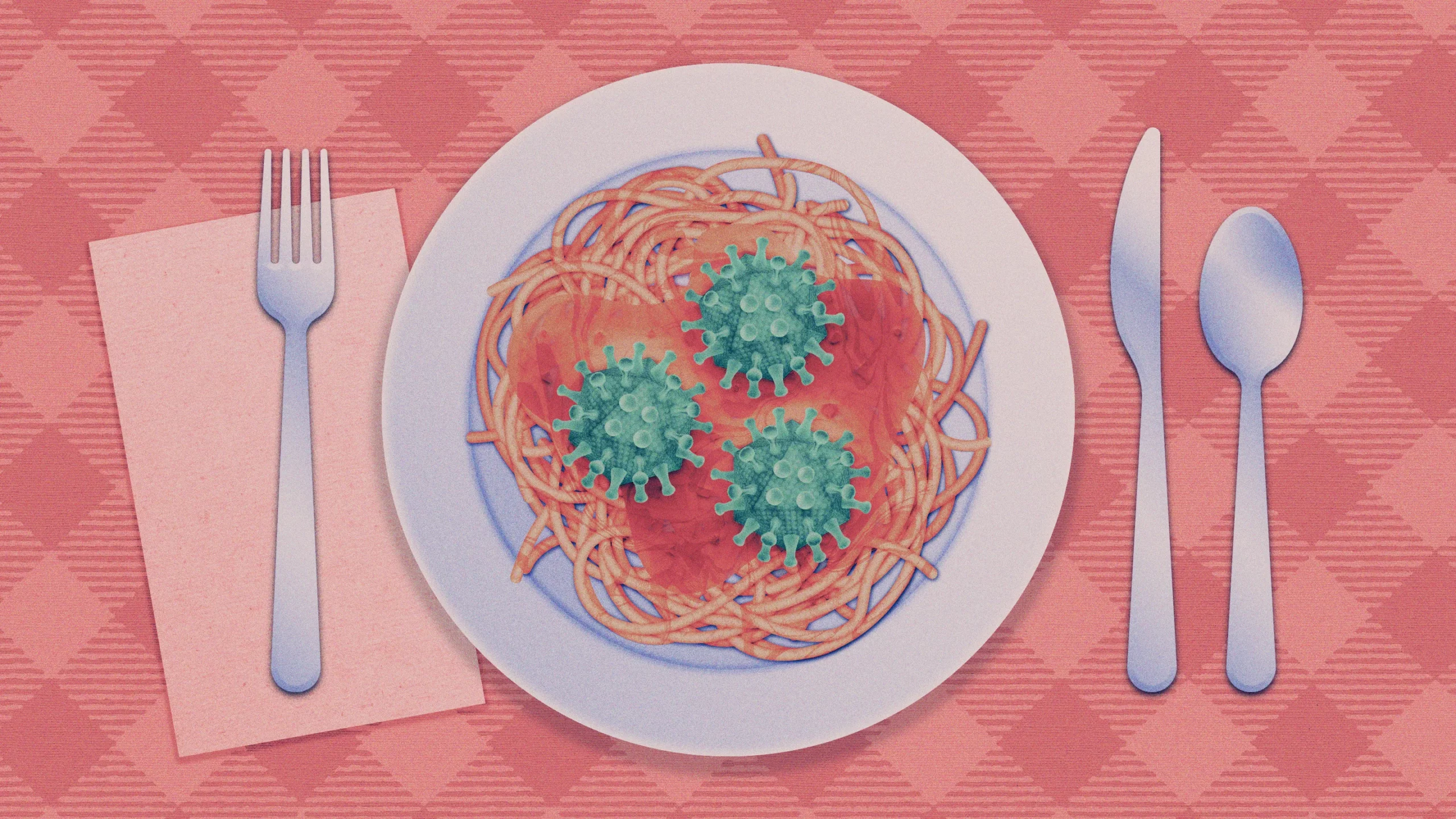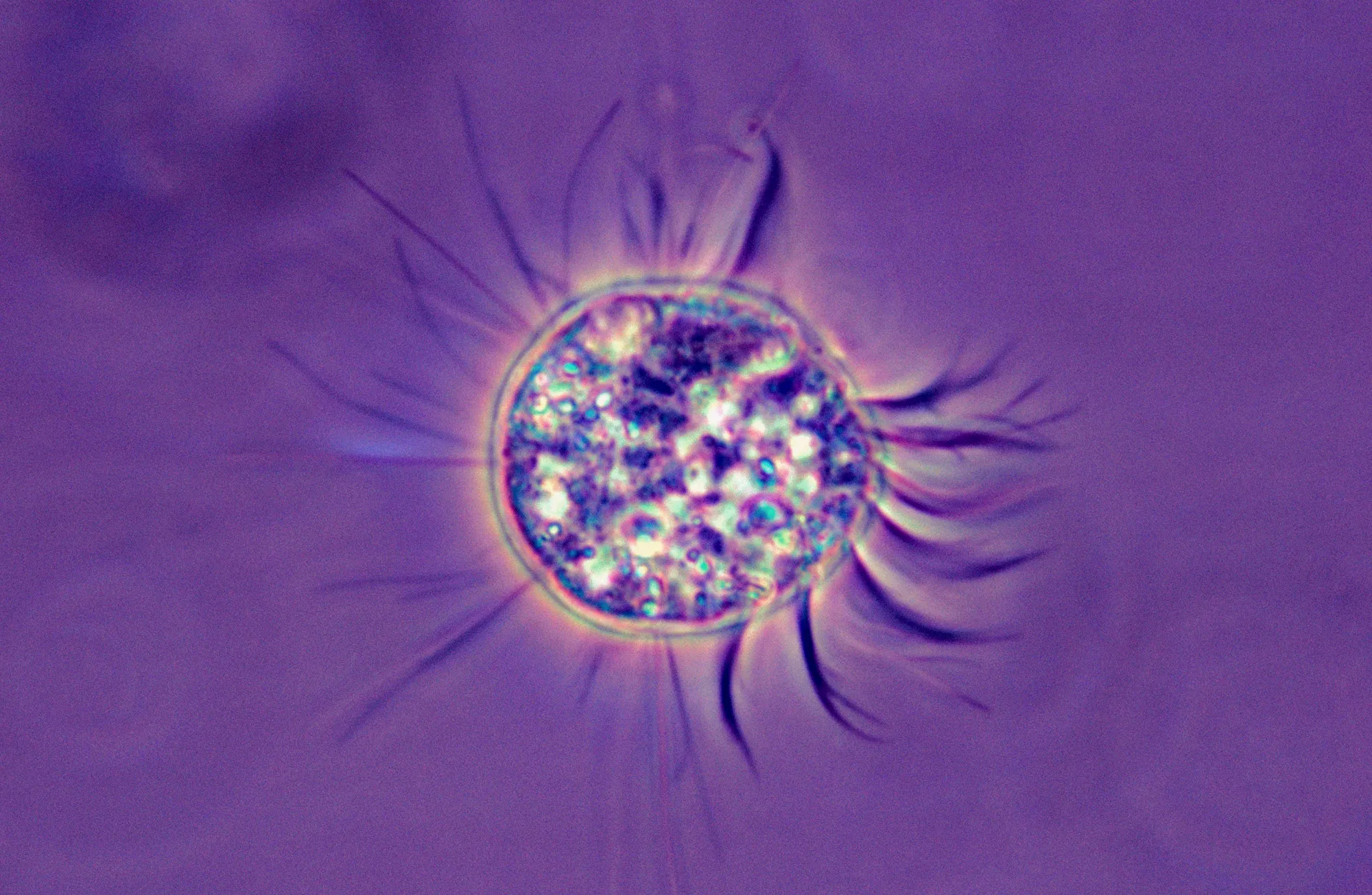With Nothing to Eat Except Viruses, Some Microbes Thrive

Viruses may be on the menu for some small aquatic organisms around the world.
Kristina Armitage/Quanta Magazine
Introduction
Viruses are notorious as scourges of cellular life, destroying as ruthlessly as any predator. Yet as microbiologists are now piecing together, these killers also sometimes perish as prey.
New research suggests that for some aquatic microorganisms, viruses can be a nutritious food source — delicious little bags chock-full of proteins, phosphorus and other yummy nutrients. Viruses “must be being eaten all the time,” said John DeLong, the lead author of the new study and an associate professor of biological sciences at the University of Nebraska, Lincoln. And if viruses are a popular enough snack for organisms across the globe, then they may have a significant impact on the cycling of energy through the food web. The study appeared in the Proceedings of the National Academy of Sciences in December.
“The dogma of viruses is that they’re killers,” said Julia Brown, a microbiologist at the Bigelow Laboratory for Ocean Sciences in Maine who was not involved in the study. The idea that they could serve as a major nutrition source for organisms “reframes the role of viruses in ecosystems.”
Holly Moeller, an assistant professor at the University of California, Santa Barbara, praised the new study as “a powerful demonstration” that some predatory microorganisms can not only adopt an all-virus diet but thrive on it.
“It’s shocking that they’re supporting their growth rate completely on viruses,” said Matt Johnson, an associate scientist at the Woods Hole Oceanographic Institution who was also not part of the study. He works every day with predatory unicellular organisms like the ones studied in the new paper, and they are “giant compared to what I would expect to see eating viruses.”
The new study and hints in samples previously gathered from waters around the world suggest that virovory (virus eating) is likely widespread — an under-explored phenomenon with potentially large effects. According to Brown, the influence that small invisible particles like viruses can have on oceans and ecosystems “can scale up really fast.”
Virovory in a Dish
Since the early 1990s, studies have suggested that some small marine organisms ingest viruses and that the viruses could in theory provide a significant amount of needed nutrients to them. But it wasn’t clear to what degree the consumed viruses were ingested incidentally, the way a dolphin pursuing fish might accidentally swallow a lot of plankton. It was also hard to say how much the viruses mattered to the organisms’ nutrition.

Ponds like this one at the Spring Creek Prairie Audubon Center near Denton, Nebraska, were the source of the water samples that the ecologist John DeLong used in his research.
John DeLong
DeLong and his team wanted to see whether there might be microorganisms that could survive on viruses alone. “We thought that could be true,” DeLong said, but no one had shown it. So he kicked off his flip-flops, grabbed a big jug and waded into ponds near his laboratory to take some samples.
When he put the murky water samples under a microscope, they resolved into teeming communities of microbes. Many of the microbes were ciliates, single-celled organisms that are common in freshwater ponds and that use tiny hairlike cilia to sweep up bacteria and other food particles.
The team separated two of the most abundant kinds of ciliates — Halteria and Paramecium — into their own lab dishes. They then flooded the dishes with chloroviruses, which are gigantic compared to most viruses but only 0.3% of the volume of a typical bacterium.
As the researchers watched over the next days, the ciliates depleted the chlorovirus population, and imaging confirmed that the viruses were ending up inside the ciliates. Moreover, as the chlorovirus populations declined, the Halteria ciliates grew in size and number. DeLong’s team had found an organism that could not only survive but flourish on a diet of nothing but viruses.
Nevertheless, DeLong wanted to make sure that what they were seeing wasn’t a fluke and that it fit with other prey-and-predator dynamics seen in nature. Through modeling, he and his team calculated that the bacteria’s growth efficiency — how effectively the Halteria could change a microgram of viral matter into a microgram of itself — was about 17%. That’s roughly on a par with the growth efficiency of other small predatory aquatic organisms, which typically ranges between 10% and 30%. What they saw in their lab dish therefore lined up with the kind of interaction they would expect to see evolve between a predator and its prey, DeLong said.
But if some marine predators do rely on a diet that consists at least partially of viruses, then these “virovores” are “playing a dangerous game,” Brown said. She thinks it’s possible that virovores evolved some unknown defense mechanism against the viruses they eat.
Beating the Viral Shunt
If virovory is widespread in nature, DeLong thinks that it could have a meaningful effect on how nutrients and energy flow through ecosystems.
Viruses have mainly been seen as trapping energy at the bottom of the food chain, through a phenomenon called the viral shunt. When viruses infect and kill microbes like bacteria, they release the cells’ nutrients into the surroundings for other bacteria to pick up. But if the energy and nutrients are just cycling between bacteria, then they aren’t flowing up the food chain to higher-order organisms.
Virovory, the authors say, could change this story. The carbon and nutrients in the viruses — much of which is taken from the hosts that the viruses infect — would cycle back into the food chain through the virus-eating organisms and flow up to higher levels. The viruses would then become part of the energy flow upward, said Jonas Albarnaz, a research associate at the Cambridge Institute for Medical Research who was not part of the study. If so, then “viruses are well integrated into the whole network of life on Earth,” he said.
It’s not yet known how much energy would flow back into the food webs in ponds, and especially in the much vaster oceans, through such a diet. DeLong and his team are now working to figure out exact numbers.

This single-celled organism, a ciliate called Halteria, can survive and multiply while eating only viruses.
M. I. Walker/Science Source
They estimated that each Halteria ciliate ate between 10,000 and 1 million virus particles a day in the lab dishes. Extrapolating from the population density of Halteria in their experiments, they calculated that about 1014 to 1016 chlorovirus particles could be consumed per day in a small pond. But many other species of viruses could also end up as prey. “This all just brings home how little we know,” DeLong said.
This ambiguity makes it difficult to pinpoint exactly how much energy might be flowing back into the food chain through virovory. A single chlorovirus particle, based on a rough estimate, represents about 10−11 to 10−10 calories, but it’s unclear how much energy in aggregate could come from the many different types and numbers of viruses that could be consumed in lakes and oceans. Still, even a small, steady extra infusion might be enough to make a difference in some ecosystems. At this point, the phenomenon is too poorly understood for generalizations to mean much. But if we think about the huge density of viruses out there, not just in ponds but in oceans, Moeller said, “the implications can be really profound.”
The Right-Size Snack
The dynamics of these interactions will undoubtedly be difficult to tease apart not only at the ecological level, but also at the level of individual organisms. Even if organisms in nature aren’t often eating viruses exclusively, the findings suggest that viruses could give them a boost, a bit more stamina to help extend their survival.
Even if virovory is widespread among small organisms, however, larger ones will likely not be able to get enough energy from viruses. DeLong may have seen a sign of that in his results: Halteria thrived on the viruses, but Paramecium, which is much larger than Halteria, did not. The paramecia ate the viruses but did not grow, possibly because they couldn’t consume enough to muster the energy to divide.
Nature sometimes produces exceptions to size limitations in predator-prey interactions. Massive baleen whales, for example, can subsist entirely on really tiny creatures like zooplankton because they have specialized mouthparts that allow them to efficiently gather such minute food particles.
Something similar could be true for virovores. “There’s probably some point at which [this diet is] not efficient anymore,” Moeller said. “But as a biologist, I’m like, ‘Never say never.’”



